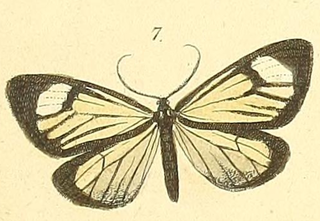
Oenosandridae is a family of Australian noctuoid moths. Genera include:

Notodontidae is a family of moths with approximately 3,800 known species. The family was described by James Francis Stephens in 1829. Moths of this family are found in all parts of the world, but they are most concentrated in tropical areas, especially in the New World. The Thaumetopoeidae are sometimes included here as a subfamily.
Doidae is a family of Lepidoptera first described by Julian P. Donahue and John W. Brown in 1987. It is sometimes treated as a subfamily of the Notodontidae. Species have been placed in the Arctiidae, Lymantriidae and the Dioptidae.
Scotura bugabensis is a moth of the family Notodontidae first described by Druce in 1895. It is found from Costa Rica south to south-eastern Peru at elevations between 0 and 600 meters
Erbessa avara is a moth of the family Notodontidae first described by Herbert Druce in 1899. It is found in Ecuador.
Erbessa cuneiplaga is a moth of the family Notodontidae first described by Louis Beethoven Prout in 1918. It is found in Suriname, French Guiana and Brazil.
Erbessa dominula is a moth of the family Notodontidae first described by William Warren in 1909. It is found in Argentina, Uruguay and Brazil.

Erbessa priverna is a moth of the family Notodontidae first described by Pieter Cramer in 1777. It is found in northern South America, extending as far west as central Venezuela. It also occurs south into Brazil.
Erbessa semimarginata is a moth of the family Notodontidae first described by Paul Dognin in 1902. It is found from Panama south to Peru and Colombia.
Erbessa tapajoza is a moth of the family Notodontidae first described by Paul Dognin in 1923. It is found in Brazil.
Polypoetes rufipuncta is a moth of the family Notodontidae. It is found in south-eastern Brazil.
Brachyglene bracteola is a moth of the family Notodontidae first described by Carl Geyer in 1832. It is found from Venezuela east to Ceará, Brazil, and south at least as far as Rio de Janeiro.
Nebulosa fulvipalpis is a moth of the family Notodontidae. It is found on mid elevations on the western slope of the Andes, from Cali, Colombia, south to Pichincha, Ecuador.

Monocreagra pheloides is a moth of the family Notodontidae first described by Cajetan and Rudolf Felder in 1874. It is found in Colombia, Ecuador and Peru.
Euchontha frigida is a moth of the family Notodontidae first described by Francis Walker in 1864. It is distributed along the eastern slope of the Andes from central Colombia south to Bolivia.
Dicentria centralis is a moth of the family Notodontidae. It is found from Mexico south to Brazil.
Dicentria violascens is a moth of the family Notodontidae. It has been recorded from Mexico south to Brazil. However, violascens is a species complex of at least six cryptic species.
Lepasta bractea is a moth of the family Notodontidae. It is found in Venezuela and Peru.
Nystaleinae is a subfamily of the moth family Notodontidae. The subfamily was described by William Trowbridge Merrifield Forbes in 1948.



